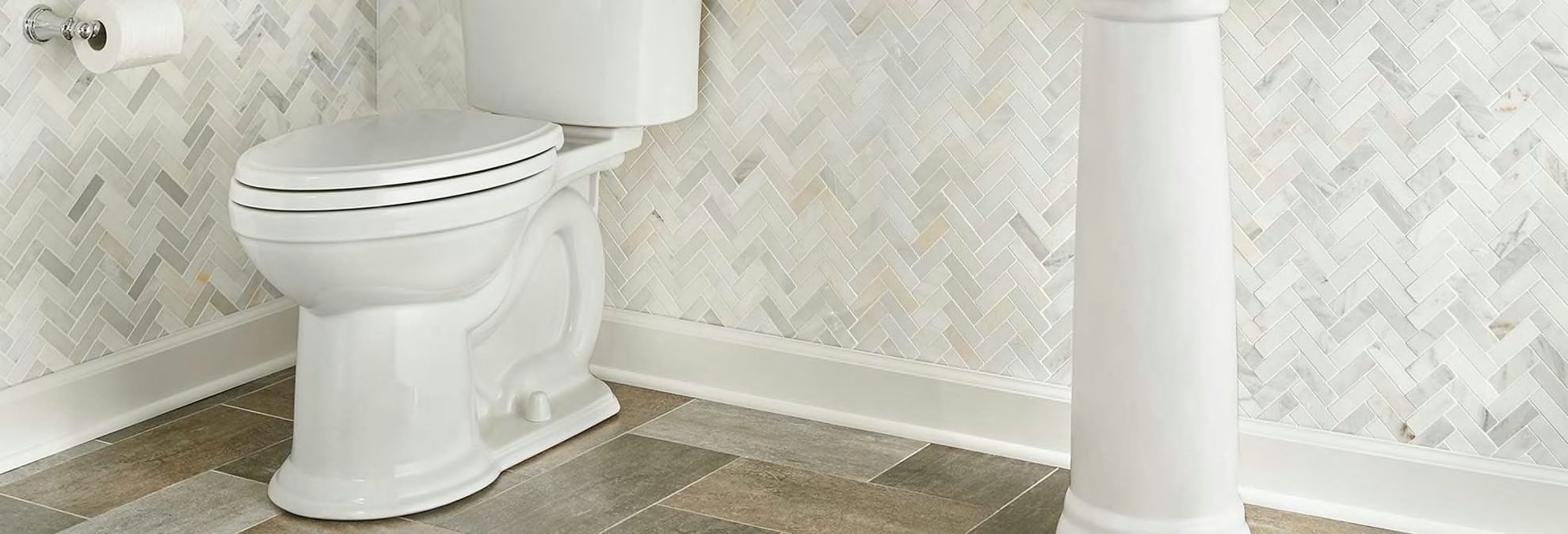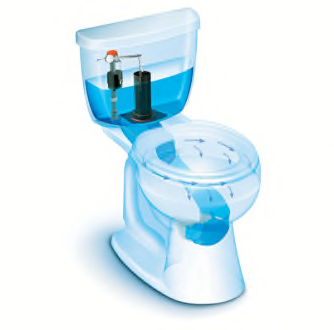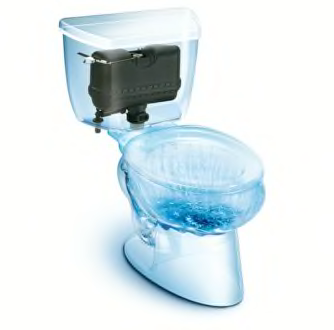
Toilet Buying Guide
When you’re in shopping mode for a new toilet, remember that a large price tag doesn’t guarantee great performance. In our tests of single- and dual-flush toilets, the ones with the top Overall Scores in our ratings were midpriced models, costing from around $200 to about $350. A handful of budget toilets, both single and dual flush, perform very well in our testing and cost below $200.
The best toilets also save water while delivering worry-free performance; in fact, some of the best water-saving toilets in our tests cost $200 or less, and some toilets can even be mounted into a wall.
In this buying guide, we cover what goes on in our lab tests for toilets, the types of toilets, and features to look out for when picking a high-performance model that’s right for your space. When you’re ready to go shopping, check out the best toilets in our tests. (If you want a bidet seat, we’ve got you covered there, too.)
How CR Tests Toilets
To rate each toilet, Consumer Reports’ test engineers put the models through a battery of tests involving waste removal, bowl cleaning, and drain-line clogs. We also measure how loud a toilet’s flushes are. Based on performance in these tests, we give each toilet an Overall Score.
To test solid-waste removal, we dump marble-sized plastic beads, weighted sponges, and water-filled condoms into the bowl and measure how well each flush handles the simulated waste.
We use two different methods to assess how well a toilet gets the entire bowl clean. First, we use a water-based red paint to create a solid rectangular shape above the waterline in the front bottom of a clean bowl. A picture is taken of the red rectangle, then the toilet is flushed two times. After the second flush a second picture is taken to record how much of the paint has been removed.
A second way we test to see how well a toilet cleans waste: We let the bowl fill up, then we draw a line using a water-soluble pen around the bowl about an inch under the rim. Next, we flush and measure how much of the pen marking is left. The better a toilet cleans, the less markings and paint are left. We repeat the pen test three times and calculate the average to arrive at a score.
To gauge soil and odor potential, we measure the length and width, as well as how deep the water is in the bowl. The deeper and wider the water, the better solid waste odors will be trapped by the water.
We also look at how well a toilet moves waste from bowl to sewer and whether there’s enough force to make sure the waste doesn’t get stuck, especially if waste travels a long way to the sewer.
For our noise tests, we measure how loud a toilet is during flushing using a decibel meter.
Types of Toilets
While there are many features to consider when buying a toilet, including height, bowl shape, color, style, and flushing technology, most toilets fall into one of two basic types: gravity-feed and pressure-assisted. Gravity-feed toilets dominate the market, but pressure-assisted models are worth a look.

Gravity-Feed Toilets
As their name implies, these toilets have a flush valve that relies on gravity. Water drops from the tank into the bowl to move waste down the drain. They can work with as little as 10 pounds per square inch of household water pressure. Models with a beefy 3-, 3½-, or even 4-inch-wide flush valve deliver more thrust in our tests than those with a 2- to 2½-inch valve. Ask to see the manufacturer’s specifications for the flush valve.
Pros: Gravity-feed toilets flush more quietly than pressure-assisted models. Many we tested work every bit as well as the best pressure-assisted models.
Cons: Lower-priced models might not be able to properly displace waste.

Pressure-Assisted Toilets
As water compresses air within the sealed tank, it creates pressure that thrusts waste forcefully down the waste line. A pressure-assisted toilet is an especially good choice for large families, but it does have a noisier flush.
Before buying, be sure that your home has at least 25 pounds per square inch of water pressure, the minimum required for a pressure-assisted toilet to work properly. To check, attach a water pressure gauge—available at most hardware stores—to an outdoor spigot.
Pros: Pressure-assisted toilets dispatch the simulated solid waste in our tests with few clogs. If you have little kids who like to stuff the toilet with toilet paper, these can be a lifesaver.
Cons: These toilets are noisy; the loudest ones emit an emphatic whoosh. They can also be expensive. They generally don’t do as well as our top-rated gravity models for drainline carry (how well waste moves through to the septic system or municipal sewer).
A Royal Flush of Features
Once you decide on the type of toilet you want to install, there are some important toilet features to consider before you buy.
- Water efficiency: A Department of Energy requirement limits new toilets to 1.6 gallons per flush. All the toilets in our tests meet that standard, and the majority of the tested models meet the stiffer California standard, which limits toilets sold in that state to 1.28 gallons per flush. The high-efficiency models that satisfy the California standard carry the EPA’s WaterSense label.
- Flapperless tanks: Newer models may come without any flappers (the rubber seal inside the tank), which can help keep leaks to a minimum without sacrificing flushing power.
- Dual-flush technology: Dual-flush toilets have two buttons on the tank that let you select a partial flush for liquid waste or a full flush for solid waste. The best models effectively flush solid waste in their full-flush mode and leave no trace of liquid waste in partial-flush mode. But other dual-flush models lack power, so you could end up having to flush twice.
- Touchless flushing: Using sensors, touchless technology lets you flush your toilet with the wave of a hand. It’s available on some toilets, or you can buy a retrofit kit—though the retrofit can’t be used on all toilet models.
- Seat height: Narrow your shopping options by making sure the new toilet matches the existing toilet’s “rough-in” measurement—the distance from the wall to the center of the toilet flange (the hold-down bolts). A measurement of 12 inches is standard, but 10-inch and 14-inch models are also available. Unlike standard bowls, whose rims stand about 14 or 15 inches above the floor, most “comfort height” toilets are 17 to 19 inches high. Some people find them to be more comfortable to use because the added height makes it easier to get on and off the throne. Wall-mounted toilets, however, can be installed at your preferred height.
- Bowl shape: A round bowl takes up less room than an elongated one. But an elongated bowl allows more seating room and is more comfortable for some users. Some manufacturers offer compact elongated bowls, which are elongated shapes that fit in the space of a toilet with a round bowl. Our ratings note the shape of each toilet.
- Bowl coating: Some bowls come with special coatings on the inside that help keep waste from sticking to the sides. Our testers note that these coatings tend to reduce residual waste and odor. In our ratings, we note whether a toilet has a nonstick coating.
- Visible, concealed, or skirted trapways: Trapways, those bends on the back of the toilet behind the bowl, are often difficult to clean. Toilets with concealed trapways feature a smooth surface where the trapway would appear. Skirted trapways have a clean line from the front to the back of the toilet. Both make cleaning the toilet base easier and offer a sleeker appearance.
- One-piece or two-piece design: Most toilets sold are two-piece models, with a separate tank that bolts onto the bowl. These tend to cost less than a one-piece design. But they can be more difficult to keep clean because the seam between the tank and bowl can trap grime.
- Noise level: If your bathroom is near a kitchen or another living area, or if your home is small, you’ll probably appreciate a relatively quiet toilet that doesn’t broadcast every flush. Our noise ratings show how quiet a toilet is during a flush.



























